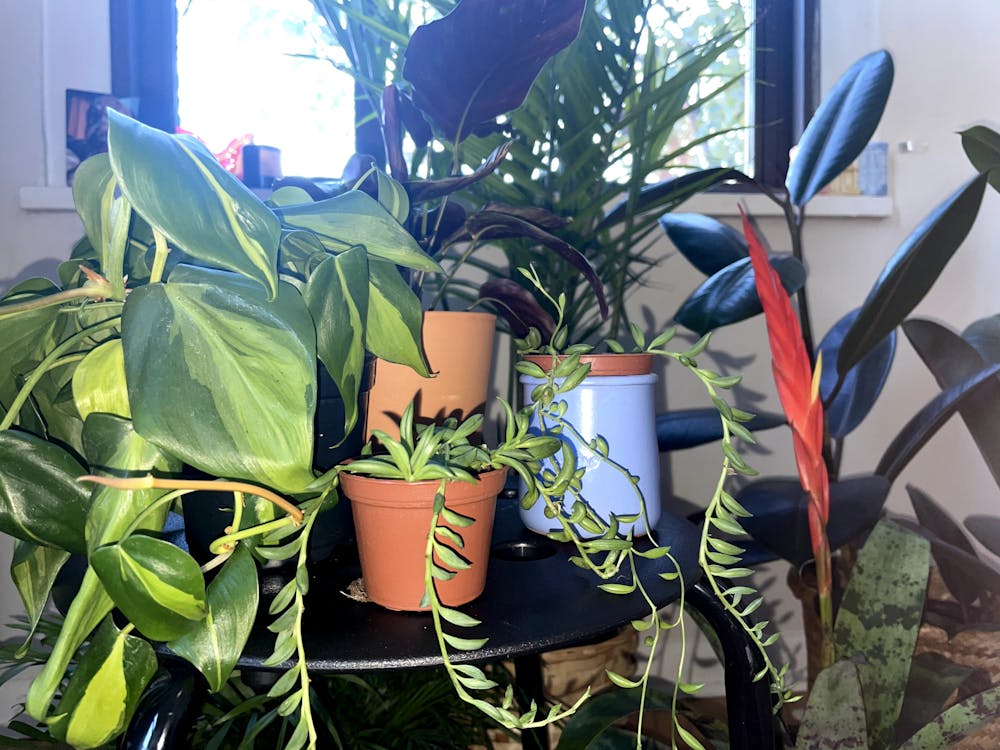We’ve all seen photos on Pinterest and Instagram and are probably guilty of the trend ourselves. Houseplants, both living and faux, have taken over our window sills and social media feeds — and for good reason. Studies suggest indoor plants can have positive effects on mental health and productivity. Plus the vibes are undeniably good. Who wouldn’t want to live in a jungle or at least bring a little life to a dark, generic dorm room?
But even if you’re ready to adopt a leafy friend, knowing where to start can feel overwhelming. In order to be an effective plant parent, you’ll need to get familiar with the basics: light, water and soil or medium.
In an interview with The News-Letter, owner of local houseplant shop B.Willow and Hopkins alum Liz Vayda suggests starting with light.
“The first thing I usually ask people is do they know what kind of light they get, and do they know where they would be putting the plant? Knowing the direction your windows face tells us a lot of information,” Vayda said. “The strength, the longevity of light that someone might be getting into their space helps determine what kind of plant they can support.”
Plant care instructions often note two aspects of light: one, the level or how much light, and two, direct vs. indirect light. Direct light refers to when the sun shines onto the plant’s leaves. Contrary to popular belief, not all plants need this — some will actually burn if they get too much direct light.
To determine the type of light you get, think about the windows in your apartment or dorm. What direction is the light coming in, and how much sun do you actually get? In my apartment the trees outside my living room windows filter some light. In some cases neighboring buildings can mean a south-facing window isn’t actually getting much direct light.
Once you know your light, Vayda recommends picking out where you want the plant to live before heading to the shop.
“Putting that idea in their head of 'where's the plant going to go' is a super important one because plants obviously don't have legs, so the more you move them around, the more stressed they can become,” she said.
Reserve the window sill of a south-facing window for plants that need lots of bright, direct light like cacti and succulents. For plants that need bright, indirect light, I have some shelves near my east-facing windows that get just a touch less sun exposure. For my medium-low light friends, some hang on various walls, perch on a side table or live on the north-facing window sill in my bedroom. I’m blessed with massive 9-foot windows in my current apartment, so these plants can live pretty much anywhere except my windowless bathroom. For dark dorm rooms, however, this may not be the case and you’ll want to make sure your plant is somewhat aligned with the window.

The next key component of plant care is watering. Different plants have different moisture needs. Plants like cacti and succulents store water in their tuberous stems, roots or thick leaves, meaning they typically need less frequent watering. Plants with thinner leaves store less water, meaning they generally dry out quicker.
Don’t water your plants according to a calendar. While it can be helpful to keep track of when they were last watered, plants' needs change throughout the year (like during dormancy periods in winter), so your watering frequency will too. Thankfully, there are a few ways your plants will let you know they’re thirsty: leaves and soil.
For many plants, the leaves wilt or droop to let you know they need water (sometimes it looks like the whole plant is lying down). Others, especially round or plump plants like string-of-pearls, will shrivel up or become squishy. Succulents can become wrinkly or squishy rather than plump or taut when they need a drink.
The best way to know when your plant is thirsty is to check how dry the soil or medium is. You can visually examine the top layer of soil and poke it with your finger. To investigate further down, carefully plunge a clean chopstick or wooden skewer into the pot (almost to the bottom), swirl it gently and remove. If the chopstick is still clean, the bottom layers of soil are pretty dry, and your plant probably could use a drink. If any soil sticks to the chopstick or it comes out damp, you can approximate how much of the soil is still wet by seeing how far up the moisture goes.
Many houseplants perish due to root rot (and often the pests that come with it), which was my personal challenge when I first got plants. I just gave each plant a little water once a week and then got disappointed when a little cactus turned to mush. I know it can be challenging because a new plant is exciting and we want to engage with it. But when it comes to watering, too much love is definitely a bad thing.
On a similar note, don’t mess with your plants unnecessarily! No matter how cute that ceramic planter you just got is, it’s best not to repot a perfectly happy plant just for aesthetics. Disturbing a plant that’s thriving is not worth the risk, so I prefer staging plastic nursery pots in other pots, baskets or hangers. The nursery pots provide drainage and allow for bottom watering, which is my preferred method to avoid root rot and fungus gnats. Bottom watering is when a plant soaks up water by placing the pot (with drainage holes) in a small tray of water for around 10 minutes.
According to Vayda, many people overlook a key aspect of plant care: pest prevention. She noted that one simple way to avoid infestations is to keep your plants free of dust, and B.Willow offers natural preventives made by small businesses.
You know how to care for it; now how to pick a plant? For first-time plant owners, Vayda recommends ZZ plants, snake plants, Pothos, Aglaonema and Dracaena varieties. Though you can find plants at all kinds of retailers, I recommend buying from a local shop like B.Willow in order to get the best advice and ensure your plant has been properly taken care of before it comes home with you.
Vayda, who earned her master’s degree in Environmental Sciences and Policy from Hopkins, opened B.Willow in Remington five and a half years ago in order to share the benefits of houseplants.
“I had just been thinking a lot about how people need to feel connected to the more-than-human world first and foremost if we're going to expect them to care about [the world] or feel some sense of connection to it,” she said. “I just kind of went for it and thankfully it was a success.”





